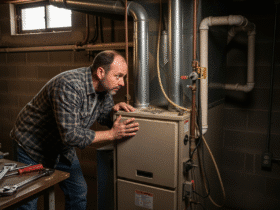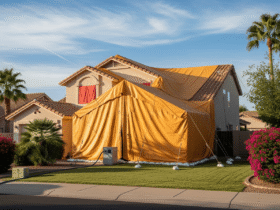Why Your Pool Area Is a Mosquito Magnet

Picture a warm summer day, the sun shining on your sparkling swimming pool. Laughter fills the air. Then, an unwelcome buzz breaks the calm. A mosquito has arrived. Soon, more follow. Your backyard oasis can quickly become a battleground against these tiny pests.
Mosquitoes are more than annoying. They can carry serious diseases like West Nile Virus and Zika. Therefore, managing them around your pool is vital for your family’s health and comfort. We understand the challenge of keeping your outdoor space enjoyable.
In this guide, we will explore everything about mosquitoes and your pool. We will look at why they are attracted to water, show you how to spot breeding grounds, and, most importantly, share proven ways to prevent and control mosquitoes. Our goal is to help you reclaim your pool area and enjoy a safe, pest-free summer.
Mosquitoes, those persistent summer pests, are drawn to our pool areas for a fundamental reason: water. While a sparkling, well-maintained pool might seem inhospitable, certain conditions can transform it or its surroundings into an ideal breeding ground. Understanding the biology of these insects helps us combat them effectively.
Mosquitoes require stagnant water for a critical part of their life cycle. After taking a blood meal (which they need for egg development), female mosquitoes seek out still water to lay their eggs. This is because mosquito eggs, larvae, and pupae are aquatic. They cannot survive in moving water. If your pool water is undisturbed, it becomes an open invitation even for a few days. Furthermore, stagnant water often encourages the growth of algae, which provides a vital food source for mosquito larvae.
Neglected swimming pools are particularly problematic. A pool that is not regularly filtered, chemically treated, or circulated can quickly become a haven for mosquitoes. The research indicates that a neglected pool means stagnant water, a breeding ground for mosquitoes to lay eggs that can produce thousands of mosquitoes in just a few weeks. While a well-maintained pool with proper circulation and chemical balance actively deters them, a neglected one can contribute significantly to local mosquito populations.
Beyond the water itself, adult mosquitoes are attracted to people near the pool. Female mosquitoes are drawn to the heat and sweat from our bodies and the carbon dioxide from our breath. This means that even if your pool is immaculate, your presence can still draw adult mosquitoes to the area.

The Mosquito Life Cycle and Water
Let’s briefly review the mosquito life cycle to understand why water is so crucial. Mosquitoes undergo complete metamorphosis, passing through four distinct stages: egg, larva, pupa, and adult.
- Egg Stage: Female mosquitoes lay their eggs directly on the surface of stagnant water or in areas that will soon be flooded. These tiny eggs, often laid in rafts, can remain dormant for months in dry conditions, only hatching when water becomes available.
- Larva Stage: Once hatched, the eggs become larvae, often called “wrigglers” due to their characteristic movement. These larvae live in the water, feeding on microorganisms and organic matter, including algae. They breathe through a siphon at the water’s surface.
- Pupa Stage: After several molts, the larvae transform into pupae, sometimes called “tumblers.” This is a non-feeding, transitional stage where the mosquito develops into adulthood. Pupae also live in the water and breathe at the surface.
- Adult Mosquito Emergence: Finally, the adult mosquito emerges from the pupal casing, flies away from the water, and begins its search for nectar (for energy) and, for females, a blood meal.
Mosquitoes spend their larval and pupal stages in standing water. The entire process, from egg to flying adult, can take approximately one week. This rapid development highlights why even temporary puddles can quickly become breeding grounds.

Maintained vs. Neglected Pools
The distinction between a well-maintained and a neglected pool is critical regarding mosquito breeding.
- Well-maintained pools actively deter mosquito breeding. Running your pumps, filtering the water, and maintaining chemical balance are essential to curbing mosquito infestation. Mosquitoes cannot lay their eggs in moving water. Therefore, running your pool pump is a great way to keep the water moving. Combining chlorine and/or other pool sanitizing methods will kill mosquito eggs and larvae long before they mature into adults. Even if a mosquito manages to lay eggs in a properly treated pool, the larvae won’t hatch or survive.
- Neglected “green” pools are a different story. If a pool has been overlooked, mosquitoes can certainly use that water to breed. A neglected pool, especially one that has turned green with algae, provides the perfect stagnant environment and food source for larvae. These pools can become massive mosquito nurseries, impacting the homeowner and the entire neighborhood. Mosquitoes become active at temperatures above 50 degrees Fahrenheit, but they require temperatures above 70 degrees Fahrenheit to thrive truly, which aligns perfectly with peak swimming pool season.
While swimming pools technically contain water, a properly maintained pool with consistent circulation and chemical treatment prevents mosquito breeding. The problem arises when maintenance lapses, turning a recreational asset into a public health concern.
Identifying and Eliminating Mosquito Breeding Zones
Even the most diligent pool owner might encounter mosquitoes if they are not aware of all potential breeding sites. Identifying these areas in and around your pool is the first step toward effective control.
The most apparent sign of mosquito breeding in water is the presence of mosquito larvae, or “wrigglers.” These tiny, worm-like creatures can be seen wiggling just beneath the water’s surface. They often come up to breathe through a siphon. You might also spot pupae, which are larger and comma-shaped, also at the surface. If you see these, you have an active breeding site. An increase in adult mosquitoes around your pool area, particularly during dusk or dawn, indicates a nearby breeding ground.

Beyond the Pool: Hidden Stagnant Water Hotspots
While a neglected pool is a prime suspect, many other everyday household items and areas can surprisingly become mosquito nurseries. These often-overlooked sources of stagnant water can contribute significantly to mosquito populations:
- Water on top of pool covers: This is a prevalent issue. Water on top of the pool covers breeds mosquitoes. If the cover doesn’t completely seal the pool, water underneath the cover will also breed mosquitoes. At least once a week, remove any accumulated water on the cover. Sweep it onto a nearby lawn or dry it with old towels. To remove larger amounts, use a shop vac.
- Clogged rain gutters: Gutters filled with leaves and debris can trap water, creating perfect breeding pools.
- Plant saucers and trays: The trays under potted plants can hold enough water for mosquitoes to lay eggs.
- Children’s toys and play equipment: Forgotten buckets, plastic toys, or small crevices in swings and slides can collect rainwater.
- Tarps and plastic sheeting: Any tarp used to cover items in the yard can collect rainwater in its folds. Ensure tarps are pulled taut or stored to prevent water accumulation.
- Bird baths and decorative fountains: While beautiful, these need regular attention. Bird baths should be drained and cleaned every 2-3 days. Fountains should have moving water to deter breeding.
- Old tires are notorious for collecting and holding water for extended periods.
- Unused flower pots, wheelbarrows, and buckets: Turn these over or store them indoors.
- Pet water bowls: While frequently refilled, they can become a breeding spot if left stagnant for a few days.
- Storm drains and street gutters: If they are not draining correctly, they can hold water. Contact your local municipality if you notice issues.
- Tree holes: Natural depressions in trees can collect water.
Mosquitoes prefer to lay eggs where the water has stayed in the sun for several days, and they only need a puddle’s worth of water to lay their eggs. Regularly inspecting and eliminating these seemingly innocuous water sources is crucial for comprehensive mosquito control. For more insights on how standing water attracts mosquitoes, you can visit our resource on how standing water attracts mosquitoes.
Signs of an Active Infestation
Beyond seeing larvae, other signs point to a mosquito problem:
- Visible larvae or pupae: These are definitive proof of breeding.
- Increased number of adult mosquitoes: If you suddenly notice a significant increase around your pool, especially at peak times like dusk and dawn, they are likely breeding nearby.
- Frequent mosquito bites around the pool area: More bites mean more mosquitoes, which often means a nearby breeding source.
- Murky, undisturbed water pockets: Any area with still, opaque water should be investigated.
Being vigilant about these signs and proactively addressing potential breeding sites will significantly reduce the mosquito population around your pool.
Proactive Pool Maintenance for Mosquito Prevention
The good news is that a well-maintained swimming pool is inherently hostile to mosquito breeding. Consistent and correct pool maintenance practices are your first and best line of defense against these pests.
The Critical Role of Circulation and Chemistry
Two primary factors make a properly maintained pool unsuitable for mosquitoes: water circulation and chemical balance.
- Water Circulation: Mosquitoes cannot lay their eggs in moving water. This is a fundamental biological requirement.
- Running the pool pump daily is perhaps the most effective way to deter mosquitoes from breeding in your pool. By constantly circulating the water, you create an environment where female mosquitoes cannot successfully deposit their eggs, and any existing larvae or pupae will be agitated and unable to breathe or feed effectively. The duration for which you run your pump will depend on your pool size and usage, but consistent daily operation is key.
- Filtration systems: A robust filtration system works in conjunction with circulation. It removes organic matter and algae from the water, which would otherwise be a food source for mosquito larvae. A clean filter ensures optimal water flow and clarity.
- Chemical Balance: The sanitizers used in swimming pools are highly effective at killing mosquito eggs and larvae.
- Chlorine’s effectiveness: Chlorine and other pool sanitizers inhibit breeding. In the rare case that a mosquito manages to drop a batch of eggs in your pool or spa, they won’t hatch. Combining chlorine and/or other pool sanitizing methods will kill them long before they mature into larvae.
- Maintaining proper pH and sanitizer levels: Regularly testing and balancing your pool’s pH, alkalinity, and sanitizer levels ensures that your chemicals work optimally. This keeps your pool safe for swimming and maintains its mosquito-repelling properties.
- Regular Cleaning and Skimming: Skimming leaves and debris: Organic debris like leaves, pollen, and insects can accumulate on the water surface or sink to the bottom. This debris can provide shelter for larvae and contribute to algae growth, a food source. Regular skimming and vacuuming remove these potential havens and food sources.
- Cleaning pool walls: Brushing pool walls helps prevent algae buildup, further reducing food availability for larvae.
By consistently implementing these pool maintenance practices, you create a dynamic, chemically hostile environment that mosquitoes will actively avoid for breeding. This proactive approach is far more effective than eliminating mosquitoes after they’ve already established a presence.

Advanced Strategies for Spot On Pool Mosquito Control
Even with diligent pool maintenance, mosquitoes can sometimes persist, especially if other breeding sources are nearby or local populations are particularly high. In such cases, a combination of advanced strategies, including seasonal management, targeted treatments, physical barriers, and professional intervention, can provide the comprehensive protection you need.
DIY Treatments and Physical Barriers
When basic maintenance isn’t enough, consider these additional measures:
- Larvicide Dunks (Bti): For standing water that cannot be easily drained, such as decorative ponds, unused pool covers, or hard-to-reach puddles, larvicides containing Bacillus thuringiensis israelensis (Bti) are an excellent option. Bti is a naturally occurring bacterium specifically targeting mosquito and blackfly larvae, and is harmless to humans, pets, and beneficial insects. These often come as “mosquito dunks” or “mosquito bits” and can be dropped into water sources.
- Insect Growth Regulators (IGR): These products interfere with the mosquito’s development, preventing larvae from maturing into biting adults. Like Bti, they are safe in water sources where mosquitoes breed.
- Installing Screen Enclosures (Lanais): Popular in tropical, mosquito-friendly climates, these screen rooms create fully secure patio living areas that block entry by nearly all bugs and insects. At the same time, a significant investment, a screened enclosure around your pool and patio area can provide a virtually 100% effective barrier against mosquitoes.
- Using Mesh Patio Curtains: For a more flexible and less permanent solution, mesh curtains provide a miniature-scale alternative to a full-screen room. You can use them to block insect intrusion into small sections of your patio where people frequently gather, such as around a dining area or seating arrangement.
- Pool Covers and Precautions: Pool covers can effectively prevent mosquito breeding by blocking access to the water. However, precautions are essential:
- Drain standing water: Regularly remove any water accumulating on the cover, as this can become a prime breeding ground. Water on top of pool covers will breed mosquitoes.
- Ensure a tight seal: If the cover doesn’t completely seal the pool, water underneath the cover will also breed mosquitoes.
- Circulate water under covers: If the pool is covered for an extended period, it’s still wise to run the pump periodically to circulate the water underneath, especially if the cover isn’t perfectly sealed.
When to Seek Professional Spot On Pool Mosquito Control
While many homeowners can manage minor mosquito issues with diligent maintenance and DIY methods, there are times when professional intervention becomes necessary:
- Significant or persistent infestations: If, despite your best efforts, you continue to experience a high number of mosquitoes, it might indicate a larger, more elusive breeding source or a remarkably resilient local population.
- Difficulty locating the breeding source: Mosquitoes can breed in surprisingly small and hidden locations. A professional pest control technician has the expertise to identify these overlooked sources.
- Health risks from mosquito-borne illnesses: A professional can offer more comprehensive protection if there’s a heightened concern about diseases like West Nile Virus or Zika in your area, or if family members experience severe reactions to bites.
- Homeowners can seek professional Spot On pool mosquito control for comprehensive property-wide solutions to create a safer outdoor environment. Professionals can implement integrated pest management strategies, including targeted larvicides and adulticides, ongoing monitoring, and customizing their specific property and local conditions. They can also help manage mosquitoes in your pool area during different seasons or weather conditions, adapting treatments as needed. For example, during cooler months when pools might be less actively used, they can advise on specific treatments to prevent dormant breeding.
Professional pest control services can provide expertise and treatment options beyond what most homeowners can achieve, offering peace of mind and a delightful, mosquito-free pool experience.

Frequently Asked Questions About Mosquitoes and Pools
To clarify common concerns, here are answers to some frequently asked questions regarding mosquitoes and swimming pools.
Can mosquitoes lay eggs in a clean, chlorinated pool?
No, the combination of constant water circulation and sanitizing chemicals like chlorine makes a well-maintained pool an inhospitable environment for mosquito eggs and larvae to survive. Mosquitoes prefer non-moving water, but they can certainly use that water to breed if the pool has been neglected. Also, chlorine and other pool chemicals inhibit breeding. A running pump prevents egg-laying, and any eggs that might be laid would not survive the chemical treatment.
What are the health risks associated with mosquitoes near my pool?
Mosquitoes are known vectors for serious diseases, including West Nile Virus, Zika virus, and various forms of encephalitis. These illnesses can range from mild, flu-like symptoms to severe neurological disease, and in some cases, can be fatal. Reducing their population is a critical step in protecting your family’s health. For example, more than 29,000 cases of West Nile virus have been reported in the U.S., including 1,160 deaths, since 1999.
Do bug zappers or citronella candles really work for pool areas?
Their effectiveness is limited. Bug zappers can kill many insects, including beneficial ones, but are generally not highly effective against biting mosquitoes. Citronella candles and torches release a scent that can confuse mosquitoes, but their protective radius is small, typically only a few feet. While they might offer some localized, temporary relief, they do not address the root cause of the mosquito problem. The most effective strategy is always to eliminate breeding grounds and use personal repellents.
Conclusion
Reclaiming your backyard oasis from mosquitoes is achievable with the proper knowledge and consistent effort. We’ve explored why mosquitoes are drawn to your pool area, the critical role of stagnant water in their life cycle, and how even a clean environment can harbor hidden breeding grounds.
The key strategies for a mosquito-free pool experience boil down to:
- Diligent Pool Maintenance: Ensure your pool pump runs regularly, your filtration system is clean, and your chemical levels are balanced. Moving, treated water is the ultimate deterrent.
- Eliminating Standing Water: Regularly inspect your entire property for hidden puddles, from neglected pool covers to clogged gutters and forgotten toys. Mosquitoes only need a puddle’s worth of water to lay their eggs.
- Proactive Control: For unavoidable standing water, use strategies like larvicides, consider physical barriers like screen enclosures, and know when to seek professional help for persistent problems.
By empowering ourselves with these insights and taking consistent action, we can transform our pool areas into the enjoyable, safe havens they were meant to be. Accept these practices, and you’ll be well on your way to enjoying a summer free from the buzz and bite of mosquitoes.










